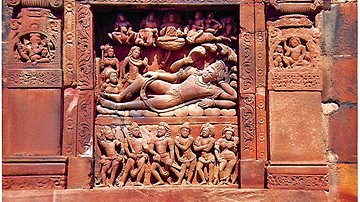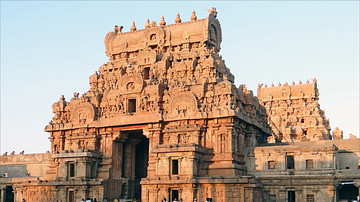
Khajuraho was an ancient city in the Madhya Pradesh region of northern India. From the 10th to 12th century CE it was the capital of the Chandella kings who ruled Bundelkhand. Despite Khajuraho's once great reputation as an important cultural centre there are no surviving non-religious buildings, but the presence of 35 Hindu and Jain temples make it one of the most significant historical sites in India today and worthy of its name given by the 11th century CE Muslim historian Abu Rihan Alberuni as 'the City of the Gods'. Khajuraho is listed by UNESCO as a World Heritage Site.
Architectural Highlights
Most of the temples at Khajuraho were built using sandstone but four also used granite in their construction. In the latter group is the Chaunsat Yogini (64 tantric goddesses), built c. 875-900 CE, which has 64 shrine rooms arranged around a rectangular courtyard. Next in the site's development came the Lalguan Mahadeva, Brahma, and Matangesvara temples which are all quite plain in design and decoration compared to the later temples.
The majority of temples at Khajuraho were constructed between 950 and 1050 CE and are either Hindu (Saiva or Vaisnava) or Jain. The most famous is the Kandariya Mahadeo built in the early 11th century CE and dedicated to Shiva. The more or less contemporary Laksmana temple was built in 954 CE by King Dhanga (r. 950-999 CE) to celebrate independence from the Gurjara-Pratihara rulers and has a similar layout and exterior to the Kandariya Mahadeo. So too does the Visvanatha temple (c. 1002 CE) which was designed by Sutradhara Chhichchha. Both temples have shrines at each corner of their terrace platforms. The Laksmana was dedicated to Vishnu and its terrace is of particular note as it carries a narrative frieze running around all four sides: Elephants, warriors, hunters, and musicians form a procession watched by a ruler and his female attendants.
Other notable temples at the site include the single-towered Caturbhuja and Vamana, the squat Matulunga, and the rectangular, more austere Parshvanatha Jain temple with its unique shrine added to the rear of the building (c. 950-970 CE). Probably the latest temple at Khajuraho is the Duladeo which was built on a star-plan.
The Kandariya Mahadeo Temple
The Kandariya Mahadeo temple is perhaps the most eye-catching building at Khajuraho and it is certainly the largest. Built around 1025 CE during the reign of Vidyadhara (r. 1004-1035 CE), the temple is an excellent example of the fully-developed North Indian temple design. The exterior has a spectacular series of towers (sikharas) which progressively reach higher from the entrance to the tallest sikhara (31 metres) above the temple's sacred shrine (garbhagriha) at the rear. The main sikhara is also surrounded by quarter and half-sikharas and is topped with a large amalaka - a ribbed circular stone. Thus the building appears like a mountain range of diverse peaks, a deliberate intention by the architect as Hindu temples were representative of the Himalayas and the 'world mountain', an effect which would have only been accentuated by its original white gesso coating, now lost.
Oriented to the east and laid out in a double-cross plan, the temple is built on a high platform base which is accessed by a flight of steps leading to a series of porches. The main porch, or mandapa, has interior polygonal columns with sculpted figure brackets which support a corbelled dome. The whole carries gavakshas – double curved arches. The interior garbhagriha is semi-circular and flanked by passages which lead to exterior balconies with stone awnings.
The Kandariya Mahadeo temple is richly decorated with sculpture; 646 figures on the exterior and 226 inside the building. The majority of figures are a little under one metre tall and arranged in two or three tiers. They are predominantly figures of Shiva and other Hindu deities such as Vishnu, Brahma, Ganesha, along with attendants, surasundaris (celestial maidens), and mithuna (lover) figures.
The erotic sculptures, which include scenes of bestiality, especially those on the south wall of the antarala, are carved in high relief with the figures depicted in all manner of acrobatic poses. Their purpose is to represent fertility and happiness, further, they are also considered auspicious and protective, an important function precisely at the architectural weak point of the building between the garbhagriha and mandapa.







